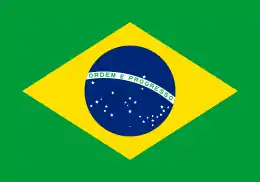| Regions with significant populations | |
|---|---|
| 400,000 | |
| 60,000 | |
| Languages | |
| Spanish and Portuguese | |
| Religion | |
| Christianity (mainly Roman Catholicism) | |
Brasiguaio (Portuguese) or brasiguayo (Spanish) is a term referring to Brazilian migrants in Paraguay and their descendants. The word Brasiguaio has been used by members within and outside this group to categorize individuals whose lives are connected with both Brazil and Paraguay, and more specifically to refer to Brazilians who live or have lived in Paraguay.[1] They typically live in the Southeastern Paraguayan departments of Canindeyú and Alto Paraná, which border with Brazil. Most emigrated from Brazil by the 1960s. In total they make up 455,000 Brasiguaios as of 2001, or about one-tenth of Paraguay's population.
In some border zones, Brasiguayos and their descendants are more than 90% of the population, where Portuguese is still spoken as the mother tongue.[2] In San Alberto de Mbaracayú city, approximately 80% of its 23,000 inhabitants are of Brazilian ancestry. The origins of Brasiguayos are from the three states of the South Region of Brazil, Paraná, Santa Catarina, and Rio Grande do Sul. Most Brasiguayos are mainly ethnically White of German, Italian, and Polish descent.[3][4]
See also
References
- ↑ Estrada, Marcos. (2015). The impact of land policies on international migration: The case of the Brasiguaios. Working Paper 120. International Migration Institute. University of Oxford. Available at: http://www.imi.ox.ac.uk/publications/the-impact-of-land-policies-on-international-migration-the-case-of-the-brasiguaios Archived 2015-10-18 at the Wayback Machine
- ↑ Souchaud, S. (2007). Geografía de la migración brasileña en Paraguay.
- ↑ Larry Rohter (2001-06-12). "San Alberto Journal; Local Cry: An Awful Lot of Brazilians in Paraguay". The New York Times. Retrieved 2016-09-25.
- ↑ Immigration, Ethnicity, and National Identity in Brazil, 1808 to the Present, p. 188, at Google Books
External links
- La presencia incómoda de los "brasiguayos" - Terramérica
- Folha de S.Paulo article (Brazilian newspaper)
- Revista do Mercosul (Mercosur Magazine)
- San Alberto Journal: Awful Lot of Brazilians in Paraguay, Locals Say - The New York Times
- BRAZIL: Brazilians in Paraguay
